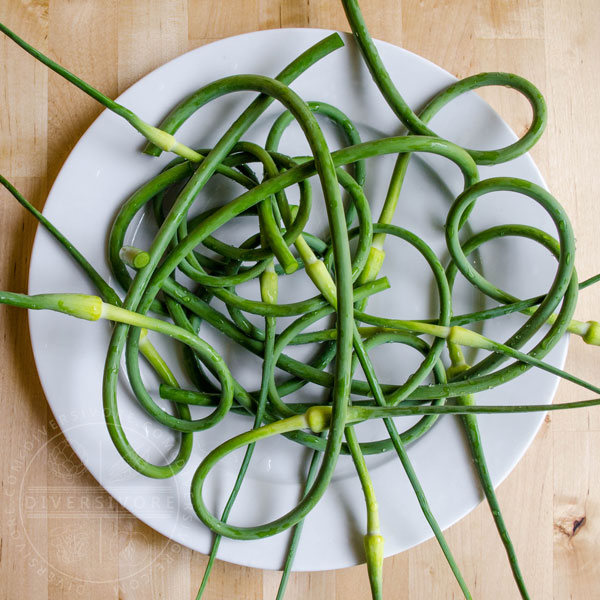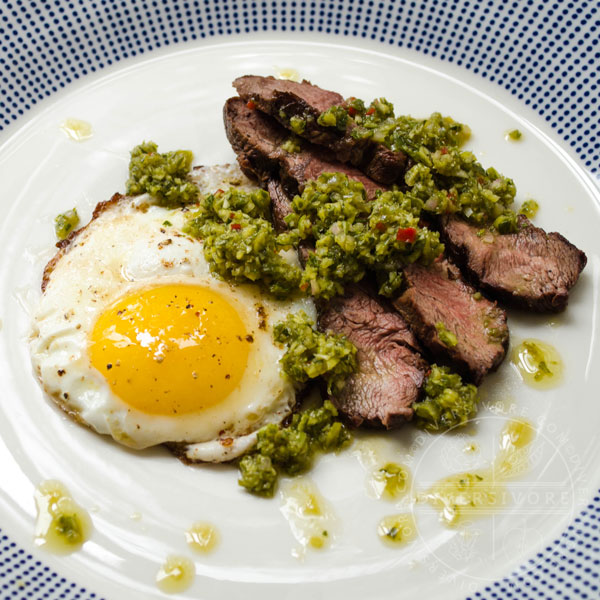How to Find, Choose, & Use
Garlic Scapes

Share this Guide
The Basics
What Is It?
The curly flower stalk of a hardneck garlic plant, picked before the flower bulb opens and while still tender.
Seasonality
Generally only available in the SPRING, though the duration of the season depends somewhat on the variety and the staggering of crop planting.
Flavour Profile
Green/Sweet/Pungent; relatively mild as a green vegetable, but with a distinctive garlic flavour and bite.
Other Names
English: Garlic stalks, garlic stems, garlic spears, serpent garlic
French: Fleurs d'ail
Italian: Scapi di aglio
Garlic Scape FAQs
Why Eat Garlic Scapes?
Well, because they're healthy and delicious, first and foremost - but there's more to it than that! The scapes are cut off of hardneck garlic before the plants can flower, thereby encouraging the plant to put more of its energy into growing the bigger, tastier garlic bulbs. As such, garlic scapes are a necessary byproduct of garlic farming, and eating them helps to avoid waste.
Can You Eat Raw Garlic Scapes?
Absolutely! Raw garlic scapes are perfectly edible, with a sharp garlicky-green flavour. Be warned though - older scapes can be quite tough, which can make them unappealing in their raw state. Try a little before you commit to using them raw in a recipe.
What do Garlic Scapes Taste Like?
Garlic scapes taste quite a bit like garlic, but with a milder 'bite' and an added sweet/green flavour. Picture something a little bit like a scallion mixed with garlic and you've got the basic idea.
Are Garlic Scapes the same as Garlic Chives or Ramps?
No. Scapes are the young flower stalks of hardneck garlic plants. Garlic chives are a similar tasting leafy green native to East Asia. Ramps are a type of wild onion that is generally harvested from the wild and eaten in its entirety (bulb and young leaves). These plants (and others) do make good substitutes for each other in some situations. For more on this, see the Culinary Info section below.
Can You Eat the Unopened Flower?
You can, but most people choose not to. The unopened, tapered flowers that can be found at the ends of the stalks are generally quite stringy, and the section right near the base of the flower bulb can be tough.
How-To
Find
Farmers markets and local farm-stands and green grocers are often the best best, but garlic scapes can sometimes be found in larger grocery stores as well.
Choose
Look for firm (but not hard), green stalks without any obvious bruising or damage. Smaller scapes are generally more tender. Ideally you want to look for scapes without yellow or papery tips on the flower bulb, as this indicates older/tougher stems.
Prep
Difficulty: Easy - Simply wash the scapes and cut off the tough bulb. The remaining scape can be chopped, diced, or used as-is. Got older/tougher scapes? Click 'Need More Details' below for tips.
Use
Can be eaten raw, or cooked. As with garlic bulbs, the taste mellows with cooking.
Store
Short Term: Keep in fresh water in a glass or vase (like cut flowers) for 2-3 days.
Medium Term: Refrigerate (unwashed) 2-3 weeks in a breathable bag in the crisper.
Long Term: Blanch in boiling water 30 seconds, drain and rinse with cold water, then chop into segments and freeze. Will keep for 6+ months, but tastes best if used within 1-2 months.
Culinary Info
Flavour Profile
Pungent/Sweet/Green - Scapes have a pleasant, tender green vegetable flavour combined with a sharp garlicky 'bite.' The garlic flavour is strongest in raw scapes, but still distinct and noticeable after cooking.
Substitutions
Substitutions vary somewhat depending on intent. Chinese/Garlic chives make a good substitute for chopped scapes, though they are often much stronger. Chives, ramps, and scallions (plus or minus added garlic) can make good substitutes. See "Substitution Note" below for details.
Cuisines
Garlic scapes appear quite frequently in modern, seasonal farm-to-table recipes. That being said, they can be encountered in cuisines from virtually any part of the temperate world (i.e. anywhere hardneck garlic is grown).
Flavour Pairings
As with garlic itself, scapes can be paired with an enormous variety of foods. Butter, oil, vinegar, lemon, sharp cheese, mild/sweet vegetables, tomatoes, and herbs are popular choices. Simple preparations that allow the flavour of the scapes to shine through are generally preferred. Sauces, soups, and purees are commonly made with scapes.
Varieties
While there are numerous varieties of hardneck garlic with different characteristics, the scapes are rarely differentiated by variety. Elephant garlic (actually a variety of bulb-forming leek) also produces edible scapes that are quite similar to true garlic scapes.
More Info
Nutrition
High in Vitamin C and calcium moderately high in fiber and protein.Nutrition FactsGarlic Scapes - 100 g (3.5 oz)Amount Per Serving (100 g)Calories 201 Calories from Fat 9% Daily Value*Fat 1g2%Sodium 23mg1%Carbohydrates 45g15%Fiber 3g13%Sugar 1g1%Protein 9g18%Vitamin C 42mg51%Calcium 248mg25%Iron 2mg11%* Percent Daily Values are based on a 2000 calorie diet.Top-To-Tail
The entire garlic scape can be eaten, though the tougher, stringier flower bud is frequently removed. The underground garlic bulb is, of course, edible too.
GMO Status
There is no GM or gene-edited garlic in the human food supply. Genetic modification and/or editing of garlic has been investigated in academic settings (see note below)
Health & Science
- Garlic is loaded with chemicals of both culinary and scientific significance. These are generally concentrated in the bulbs, but many can be found in some quantity in the scapes as well
- Garlic scapes are higher in Vitamin C and calcium than the bulbs, and (more importantly) are generally eaten in much larger quantities, making them more nutritionally significant.
- Several sulfur-containing compounds are responsible for the pungent and distinctive flavours of garlic. The compound allicin, which is primarily responsible for the perceived heat of garlic, is deactivated by cooking.Organic vs. Conventional
As a fairly niche and local crop, garlic scapes may be grown using a variety of conventional or organic methods, thought certified organic products may be hard to come by. Garlic is a hardy, pest-resistant crop that generally requires little intervention regardless of growing method.
Share this Guide


